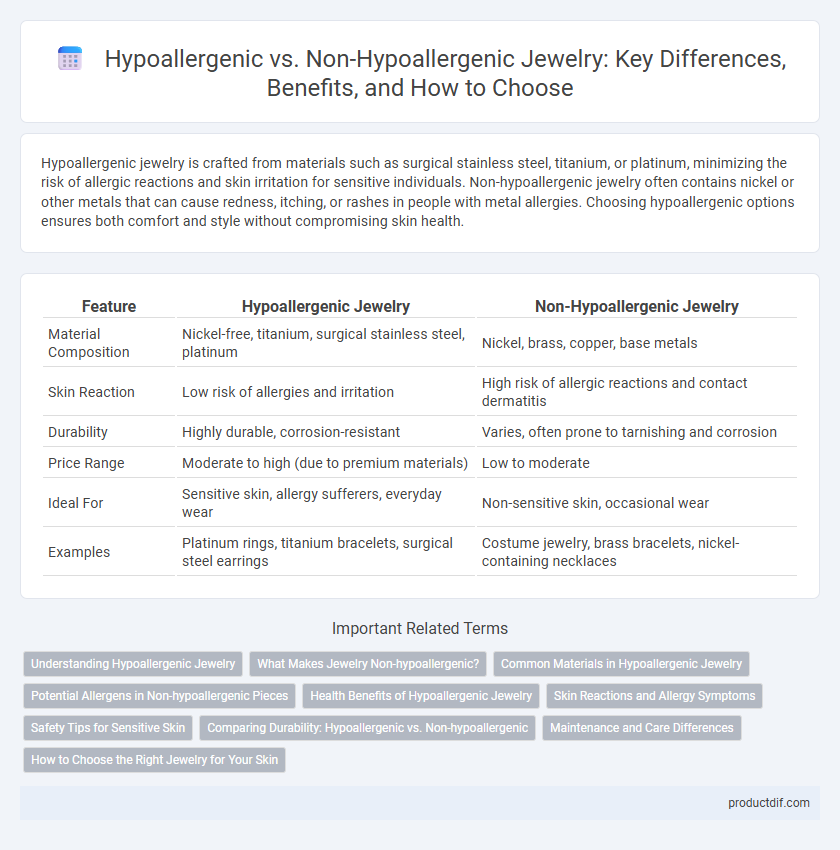Hypoallergenic jewelry is crafted from materials such as surgical stainless steel, titanium, or platinum, minimizing the risk of allergic reactions and skin irritation for sensitive individuals. Non-hypoallergenic jewelry often contains nickel or other metals that can cause redness, itching, or rashes in people with metal allergies. Choosing hypoallergenic options ensures both comfort and style without compromising skin health.
Table of Comparison
| Feature | Hypoallergenic Jewelry | Non-Hypoallergenic Jewelry |
|---|---|---|
| Material Composition | Nickel-free, titanium, surgical stainless steel, platinum | Nickel, brass, copper, base metals |
| Skin Reaction | Low risk of allergies and irritation | High risk of allergic reactions and contact dermatitis |
| Durability | Highly durable, corrosion-resistant | Varies, often prone to tarnishing and corrosion |
| Price Range | Moderate to high (due to premium materials) | Low to moderate |
| Ideal For | Sensitive skin, allergy sufferers, everyday wear | Non-sensitive skin, occasional wear |
| Examples | Platinum rings, titanium bracelets, surgical steel earrings | Costume jewelry, brass bracelets, nickel-containing necklaces |
Understanding Hypoallergenic Jewelry
Hypoallergenic jewelry is designed to minimize the risk of allergic reactions by using materials such as surgical-grade stainless steel, titanium, and nickel-free alloys known to be safe for sensitive skin. Non-hypoallergenic jewelry often contains nickel or other common allergens that can cause irritation, redness, or rashes in susceptible individuals. Choosing hypoallergenic pieces ensures better skin compatibility and long-term comfort for those prone to metal allergies.
What Makes Jewelry Non-hypoallergenic?
Jewelry is considered non-hypoallergenic primarily due to the presence of nickel, cobalt, or other metals that commonly trigger allergic reactions. These metals can cause skin irritation, redness, and itching when worn for extended periods. Manufacturing processes and metal alloys used in lower-quality jewelry often fail to eliminate or properly coat these reactive metals, increasing the likelihood of sensitivity.
Common Materials in Hypoallergenic Jewelry
Common materials in hypoallergenic jewelry include surgical stainless steel, titanium, niobium, and platinum, known for their low nickel content and minimal risk of causing allergic reactions. Hypoallergenic pieces often use high-quality gold alloys such as 14k or higher, as lower karat gold may contain irritants like nickel or copper. These materials are preferred to reduce skin irritation and ensure comfort for sensitive individuals.
Potential Allergens in Non-hypoallergenic Pieces
Non-hypoallergenic jewelry commonly contains nickel, cobalt, and chromium, which are frequent triggers of allergic reactions such as contact dermatitis and itching. These potential allergens can cause skin irritation, redness, and inflammation, especially in individuals with sensitive skin or metal allergies. Choosing hypoallergenic metals like titanium, surgical stainless steel, or niobium significantly reduces the risk of allergic responses when wearing jewelry.
Health Benefits of Hypoallergenic Jewelry
Hypoallergenic jewelry is crafted from materials such as surgical-grade stainless steel, titanium, or platinum, minimizing the risk of allergic reactions and skin irritations. Non-hypoallergenic jewelry often contains nickel and other metals that can trigger dermatitis and sensitivity in susceptible individuals. Choosing hypoallergenic jewelry provides significant health benefits by preventing inflammation, rashes, and long-term skin damage while ensuring comfort and safety for sensitive skin types.
Skin Reactions and Allergy Symptoms
Hypoallergenic jewelry is specifically designed to minimize skin reactions by using metals such as titanium, surgical stainless steel, and platinum, which reduce the risk of allergic contact dermatitis. Non-hypoallergenic jewelry often contains nickel or cobalt, common allergens that can cause redness, itching, swelling, and rash on sensitive skin. Choosing hypoallergenic options is crucial for individuals prone to metal allergies to prevent persistent irritation and discomfort.
Safety Tips for Sensitive Skin
Choose hypoallergenic jewelry made from materials like titanium, surgical stainless steel, or 14k gold to reduce allergic reactions and skin irritation. Avoid nickel-containing alloys and low-quality metals known to cause rashes or itching in sensitive skin. Regularly clean jewelry to prevent buildup of allergens and remove pieces before exposure to harsh chemicals or prolonged moisture.
Comparing Durability: Hypoallergenic vs. Non-hypoallergenic
Hypoallergenic jewelry typically features metals such as titanium, platinum, and surgical-grade stainless steel, known for their superior resistance to tarnish and corrosion, ensuring long-lasting durability even for sensitive skin. Non-hypoallergenic pieces, often made from alloyed metals containing nickel or brass, may offer less resistance to wear and cause allergic reactions over time, compromising both comfort and durability. Prioritizing hypoallergenic materials not only protects skin but also guarantees extended jewelry lifespan through enhanced metal stability and strength.
Maintenance and Care Differences
Hypoallergenic jewelry, typically made from materials like titanium, surgical stainless steel, or nickel-free alloys, requires less frequent cleaning to prevent skin irritation and allergy reactions, ensuring longevity with minimal upkeep. Non-hypoallergenic jewelry often contains metals such as nickel or copper, which can tarnish or cause allergic responses, demanding more rigorous cleaning routines and careful handling to avoid skin discomfort and maintain appearance. Proper storage and gentle cleaning solutions are essential for preserving both types, but hypoallergenic pieces typically withstand wear better with lower maintenance efforts.
How to Choose the Right Jewelry for Your Skin
Choosing the right jewelry for your skin involves understanding the difference between hypoallergenic and non-hypoallergenic materials. Hypoallergenic jewelry, often made from surgical-grade stainless steel, titanium, or 14k gold and above, minimizes the risk of allergic reactions and is ideal for sensitive skin. Non-hypoallergenic pieces, frequently composed of nickel, brass, or lower-quality alloys, may cause irritation or contact dermatitis, so selecting jewelry based on your skin's sensitivity ensures comfort and prevents adverse reactions.
Hypoallergenic vs Non-hypoallergenic Infographic

 productdif.com
productdif.com